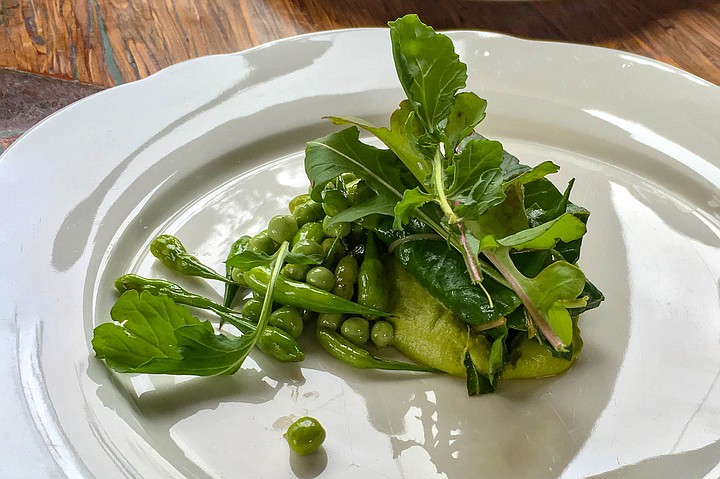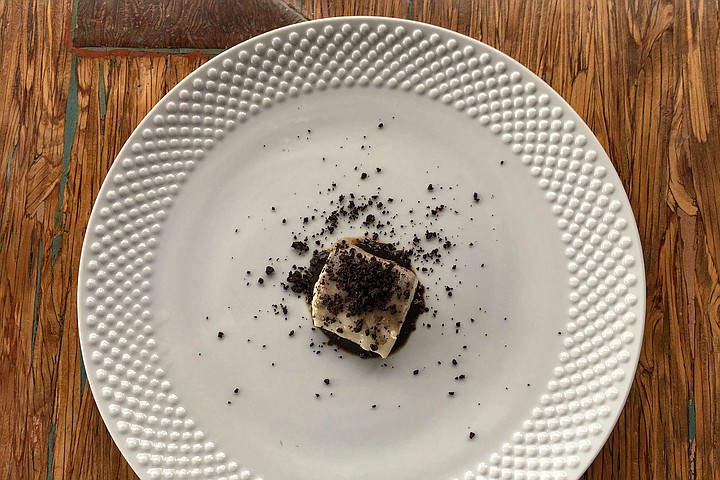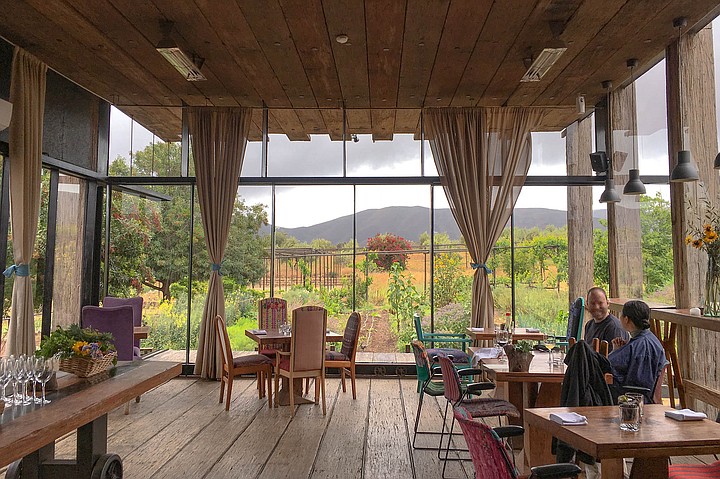 Facebook
Facebook
 X
X
 Instagram
Instagram
 TikTok
TikTok
 Youtube
Youtube

The meal started with a platter of shellfish, each harvested off the coast of Baja California, whether on the Pacific or Sea of Cortez side. There were kumamoto oysters, tiny Cortez clams swimming in local olive oil, and a pickled mule paw clam garnished with cilantro flower; each bivalve embellished to complement but not overwhelm nuanced ocean flavors. Our tastebuds came alive. We're in heaven, and we still had eleven courses to go.
We’d come for the spring tasting menu at Corazon de Tierra, a top dining destination in Mexico’s wine country, the Valle de Guadalupe. Helmed by Chef Diego Hernandez, Corazon adjoins the winery Vena Cava, which serves tastings within a wine cave capped by an overturned boat. The restaurant proves less whimsical, more elegant. Its terrarium dining room looks over a pond and fountain on one side, a robust garden on the other.

This being a rainy weekday afternoon, the three of us had the dining room to ourselves, enjoying our raw selections while at least twice as many chefs prepared courses of meat, seafood, and vegetables connected in some way to the Baja region, if not the valle. Along with fish from local waters, it might well be an uncommon herb used by indigenous people going back centuries.

At one point early on, we noticed a chef leave the open kitchen area and walk out of the building. A moment later we watched her through the dining room windows, strolling through the garden, pausing to harvest vegetables we couldn’t make out. Within a few minutes we were served a green mole dish, with leafy greens and freshly picked peas. I don’t know that there’s a vegetable that changes flavor after you pick it more than peas, and you can’t get peas that taste this good at the grocery store. But the highlight was that pipian mole, anchored by the nuttiness of ground pumpkin seeds and the flavor you want to keep around, get to know, and hope it turns into something serious.

Part of the appeal of the twelve-course meal is the surprise that comes with each plate, and the bit of local history attached to it, so with plenty of spring to go, I won’t reveal spoilers (three of our courses were desserts!). But if you were to ask me how much I enjoyed the local sea bass and tapenade with dried black olive crumbles, I would have to answer by explaining how much this meal cost.

Whether lunch or dinner, it’s tasting menu only, reservations paid in advance, priced at 1500 pesos per person, plus 270 gratuity. That comes to about 95 bucks each, depending on exchange rate, not including individual drinks or the $60 course wine pairings. We paid that, so we could cross the border, drive a couple hours south, navigate a network of rutted dirt roads to the heart of a sleepy valley, then spend 2.5 hours gushing over carefully constructed plates of delicious food, featuring ingredients we couldn’t always pronounce correctly.
Without question, worth every damn peso.


The meal started with a platter of shellfish, each harvested off the coast of Baja California, whether on the Pacific or Sea of Cortez side. There were kumamoto oysters, tiny Cortez clams swimming in local olive oil, and a pickled mule paw clam garnished with cilantro flower; each bivalve embellished to complement but not overwhelm nuanced ocean flavors. Our tastebuds came alive. We're in heaven, and we still had eleven courses to go.
We’d come for the spring tasting menu at Corazon de Tierra, a top dining destination in Mexico’s wine country, the Valle de Guadalupe. Helmed by Chef Diego Hernandez, Corazon adjoins the winery Vena Cava, which serves tastings within a wine cave capped by an overturned boat. The restaurant proves less whimsical, more elegant. Its terrarium dining room looks over a pond and fountain on one side, a robust garden on the other.

This being a rainy weekday afternoon, the three of us had the dining room to ourselves, enjoying our raw selections while at least twice as many chefs prepared courses of meat, seafood, and vegetables connected in some way to the Baja region, if not the valle. Along with fish from local waters, it might well be an uncommon herb used by indigenous people going back centuries.

At one point early on, we noticed a chef leave the open kitchen area and walk out of the building. A moment later we watched her through the dining room windows, strolling through the garden, pausing to harvest vegetables we couldn’t make out. Within a few minutes we were served a green mole dish, with leafy greens and freshly picked peas. I don’t know that there’s a vegetable that changes flavor after you pick it more than peas, and you can’t get peas that taste this good at the grocery store. But the highlight was that pipian mole, anchored by the nuttiness of ground pumpkin seeds and the flavor you want to keep around, get to know, and hope it turns into something serious.

Part of the appeal of the twelve-course meal is the surprise that comes with each plate, and the bit of local history attached to it, so with plenty of spring to go, I won’t reveal spoilers (three of our courses were desserts!). But if you were to ask me how much I enjoyed the local sea bass and tapenade with dried black olive crumbles, I would have to answer by explaining how much this meal cost.

Whether lunch or dinner, it’s tasting menu only, reservations paid in advance, priced at 1500 pesos per person, plus 270 gratuity. That comes to about 95 bucks each, depending on exchange rate, not including individual drinks or the $60 course wine pairings. We paid that, so we could cross the border, drive a couple hours south, navigate a network of rutted dirt roads to the heart of a sleepy valley, then spend 2.5 hours gushing over carefully constructed plates of delicious food, featuring ingredients we couldn’t always pronounce correctly.
Without question, worth every damn peso.
Comments